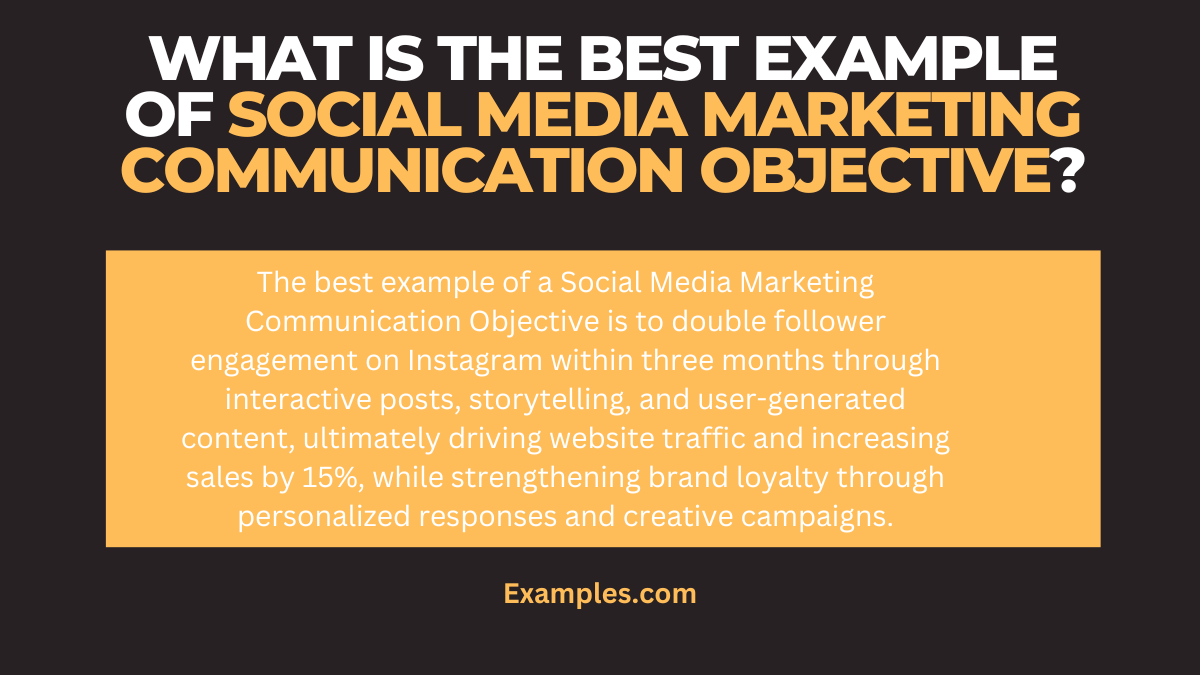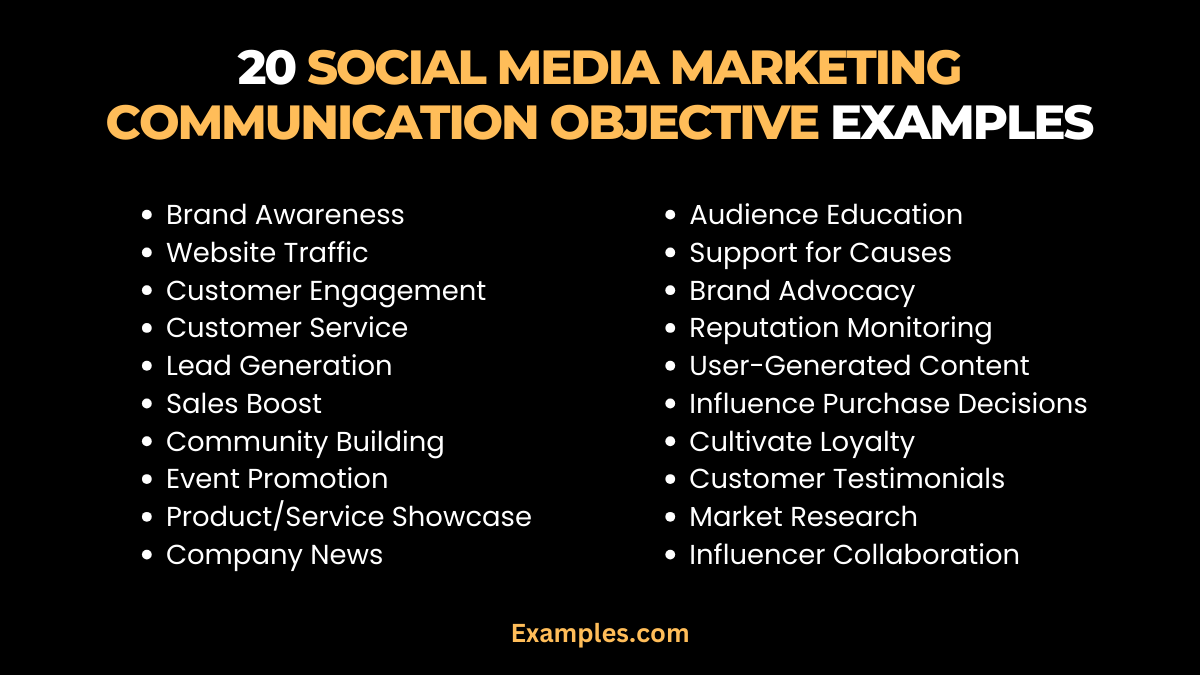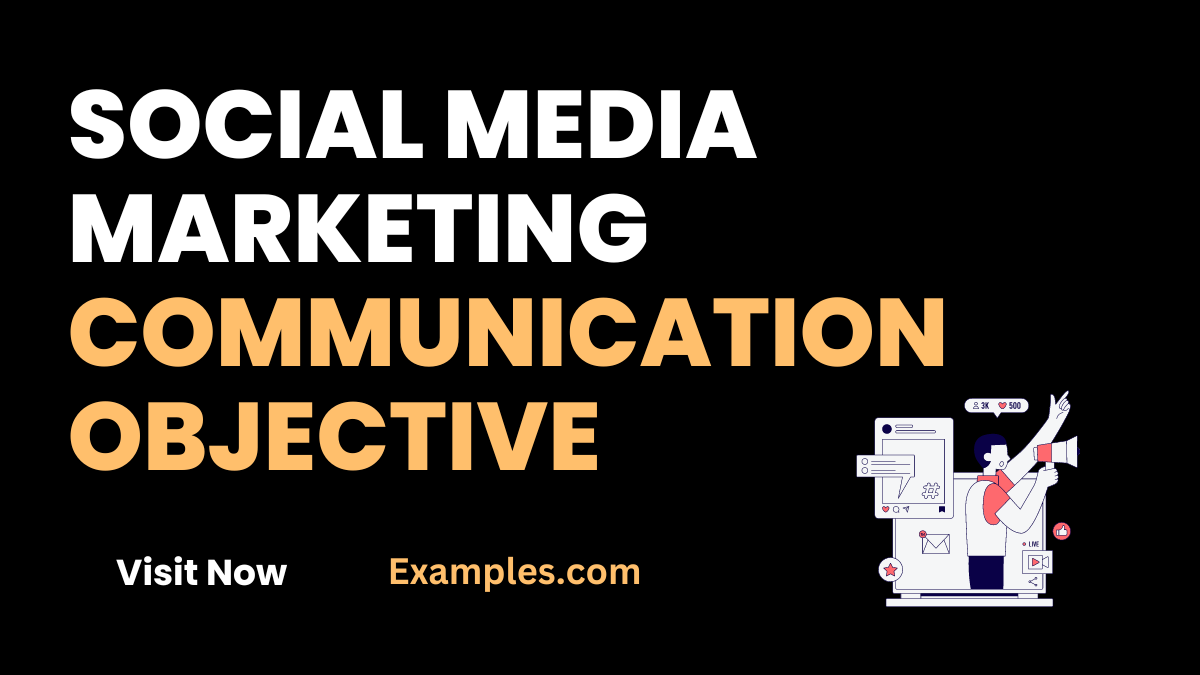19+ Social Media Marketing Communication Objective Examples
Social media has revolutionized how businesses communicate with their audiences. In this complete guide, we delve into the intricacies of setting and achieving Social Media Marketing Communication Objectives. With a focus on practical, real-world communication examples, you’ll learn to craft strategies that resonate with your target audience. Whether you’re a beginner or a seasoned marketer, this guide provides insights and examples to enhance your social media communication effectiveness, ensuring your message not only reaches but also engages your audience.
What is Social Media Marketing Communication Objective?

A Social Media Marketing Communication Objective is a specific goal that a business or individual aims to achieve through their social media channels. These objectives guide the content, style, and approach of communications on platforms like Facebook, Twitter, Instagram, and LinkedIn. Essentially, they determine what you want to accomplish with your social media presence, whether it’s increasing brand awareness, driving sales, engaging with customers, or building a community. Setting clear objectives is crucial for creating focused, effective social media strategies and measuring their success.
What is the Best Example of Social Media Marketing Communication Objective?

One of the best examples of a Social Media Marketing Communication Objective is increasing brand awareness. This involves using social media platforms to enhance the visibility and recognition of a brand among a wider audience. Strategies might include creating shareable content, engaging with followers through interactive posts, and utilizing targeted advertising. For instance, a company may launch a campaign featuring eye-catching graphics and compelling stories about their products, encouraging users to share these posts. By measuring the increase in followers, shares, and mentions, the effectiveness of these efforts in boosting brand awareness can be evaluated. This objective is vital for businesses looking to expand their reach and establish a stronger presence in the digital marketplace.
20 Social Media Marketing Communication Objective Examples

Social media marketing communication objectives are essential for any business looking to thrive in the digital space. These objectives guide how a brand communicates with its audience, ensuring messages are impactful and aligned with overall marketing goals. From increasing brand awareness to driving website traffic, each objective targets specific outcomes.
- Increase Brand Awareness: Boost your brand’s visibility by sharing engaging content. Example: “Check out our latest eco-friendly products! #GreenLiving”
- Drive Website Traffic: Use compelling calls-to-action to direct followers to your website. Example: “Discover more amazing deals on our website! Click the link in bio.”
- Enhance Customer Engagement: Create interactive posts to encourage audience participation. Example: “Tell us your favorite product and why! We love hearing from you.”
- Improve Customer Service: Respond promptly to customer inquiries and feedback on social media.
Example: “Thanks for reaching out! We’re here to help. What can we assist you with today?” - Generate Leads: Use targeted ads and lead magnets to attract potential customers.
Example: “Sign up for our newsletter to get exclusive offers and insights!” - Boost Sales: Promote special offers and discounts.
Example: “Flash Sale! 20% off all items for the next 24 hours!” - Build a Community: Foster a sense of belonging among followers.
Example: “Join our community of fitness enthusiasts for daily tips and support!” - Promote Events: Increase attendance at events by sharing engaging event-related content. Example: “Don’t miss our live webinar on digital marketing strategies. Register now!”
- Showcase Products/Services: Highlight the unique features of your offerings.
Example: “Our new skincare range is here! Formulated with natural ingredients for glowing skin.” - Share Company News: Keep your audience updated on the latest developments.
Example: “We’re thrilled to announce the opening of our new store!” - Educate Your Audience: Provide valuable information related to your industry.
Example: “Did you know? Our eco-friendly packaging helps reduce environmental impact.” - Support Causes: Align your brand with social causes.
Example: “We stand for sustainability. Join us in our journey towards a greener planet.” - Create Brand Advocates: Encourage satisfied customers to share their experiences.
Example: “Love our products? Share your story using #MyBrandExperience!” - Monitor Brand Reputation: Actively listen and respond to what’s being said about your brand. Example: “We appreciate your honest feedback and are constantly working to improve.”
- Leverage User-Generated Content: Share content created by your customers.
Example: “Thanks for the amazing photo, @username! We love seeing our products in action.” - Influence Purchase Decisions: Provide information that helps consumers make buying decisions.
Example: “Wondering which product is right for you? DM us for personalized recommendations!” - Cultivate Loyalty: Reward followers with exclusive offers.
Example: “Our loyal customers get first access to our new collection. Stay tuned!” - Highlight Customer Testimonials: Share positive reviews and testimonials.
Example: “Here’s what our happy customer has to say about our service. #CustomerLove” - Conduct Market Research: Use polls and surveys to gather insights.
Example: “Help us choose our next product color! Vote in our poll.” - Collaborate with Influencers: Partner with influencers to expand your reach.
Example: “Excited to collaborate with @influencer_name to bring you something special. Stay tuned!”
Social Media Marketing Communication Objective Goals
Setting specific goals for Social Media Marketing Communication is crucial for the success of any digital marketing strategy. These goals ensure that your social media efforts align with your overall business objectives, whether it’s enhancing brand reputation, improving customer engagement, or driving sales. Each goal should be SMART: Specific, Measurable, Achievable, Relevant, and Time-bound.
- Increase Conversion Rate: Aim to transform a higher percentage of followers into customers. Example: “Use this code for a 10% discount on your first purchase.”
- Grow Follower Base: Expand your social media audience organically.
Example: “Follow us for the latest updates in sustainable living!” - Improve Content Reach: Enhance the visibility of your posts.
Example: “Help us spread the word! Share this post with your friends.” - Strengthen Brand Identity: Establish a unique brand voice and personality.
Example: “Our brand stands for innovation and quality. Experience the difference.” - Enhance Content Quality: Regularly produce high-quality, engaging content.
Example: “Check out our latest blog post for tips on eco-friendly living.”
Setting Objectives for Social Media Marketing Communication Plans:
The process of setting objectives for Social Media Marketing Communication Objective Plans involves identifying what you want to achieve through your social media activities and how these align with your broader marketing and business goals. It’s about being strategic in your approach to ensure that every post, ad, or campaign contributes to these objectives.
- Identify Target Audience: Clearly define who you want to reach.
Example: “Our content is tailored for young, environmentally-conscious consumers.” - Determine Key Performance Indicators (KPIs): Set metrics to measure success.
Example: “We’ll track engagement rates and follower growth.” - Establish Brand Voice: Define how your brand communicates.
Example: “Our brand voice is friendly, informative, and approachable.” - Create a Content Calendar: Plan your social media posts in advance.
Example: “Our monthly content calendar includes thematic posts and product highlights.” - Allocate Resources: Decide on the budget and manpower for social media.
Example: “We’ve allocated a dedicated team for our social media campaigns.”
Which of the Following is an Objective of Marketing Communications for Social Media?
Marketing communications for social media focus on several key objectives:
- Building Brand Awareness: Increasing brand visibility and recognition.
- Driving Website Traffic: Directing followers to a website or landing pages.
- Lead Generation: Collecting potential customer information.
- Enhancing Customer Engagement: Building a community through interactive content.
- Improving Customer Service: Using social media for responsive customer support.
- Product Promotion and Sales: Showcasing and selling products or services
In conclusion, this comprehensive guide on Social Media Marketing Communication Objectives offers valuable insights and examples for businesses aiming to enhance their digital presence. By understanding and implementing these objectives, companies can effectively communicate with their audience, build brand awareness, and achieve marketing success in the ever-evolving social media landscape.



